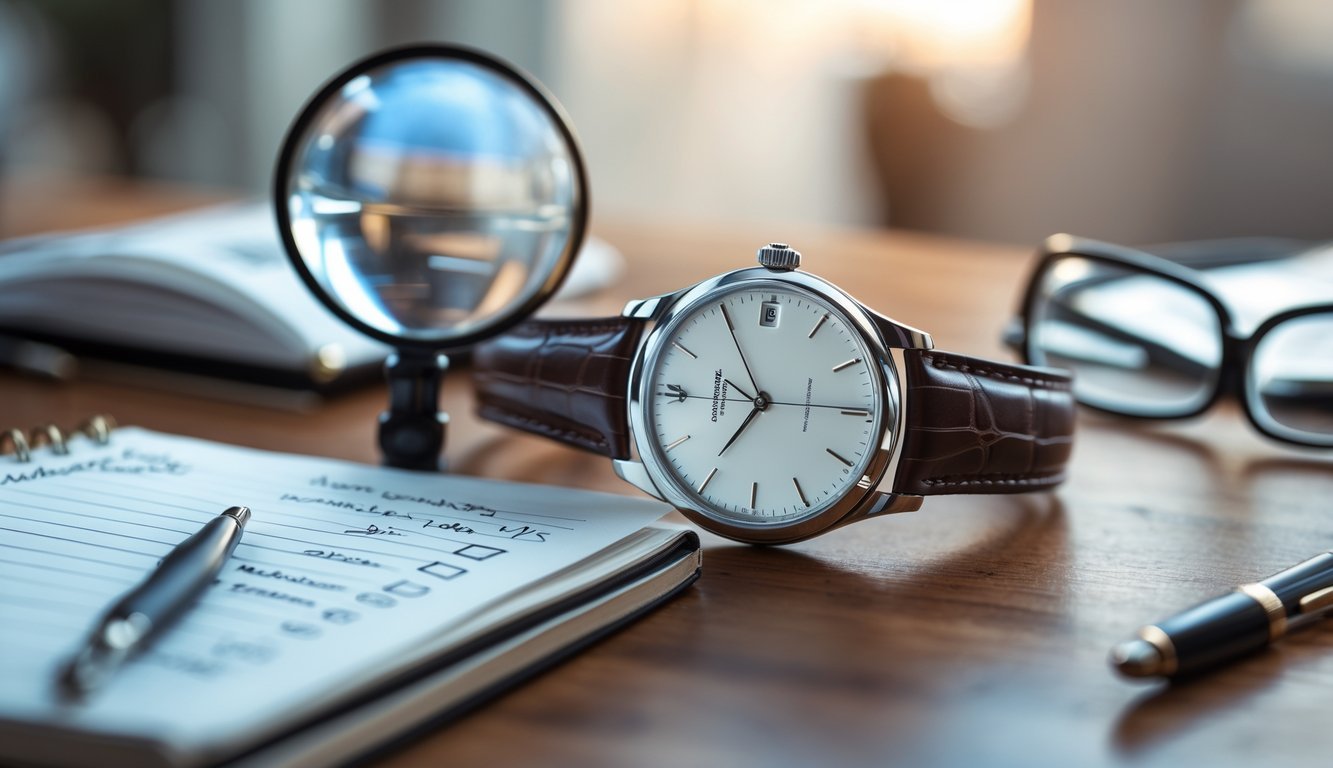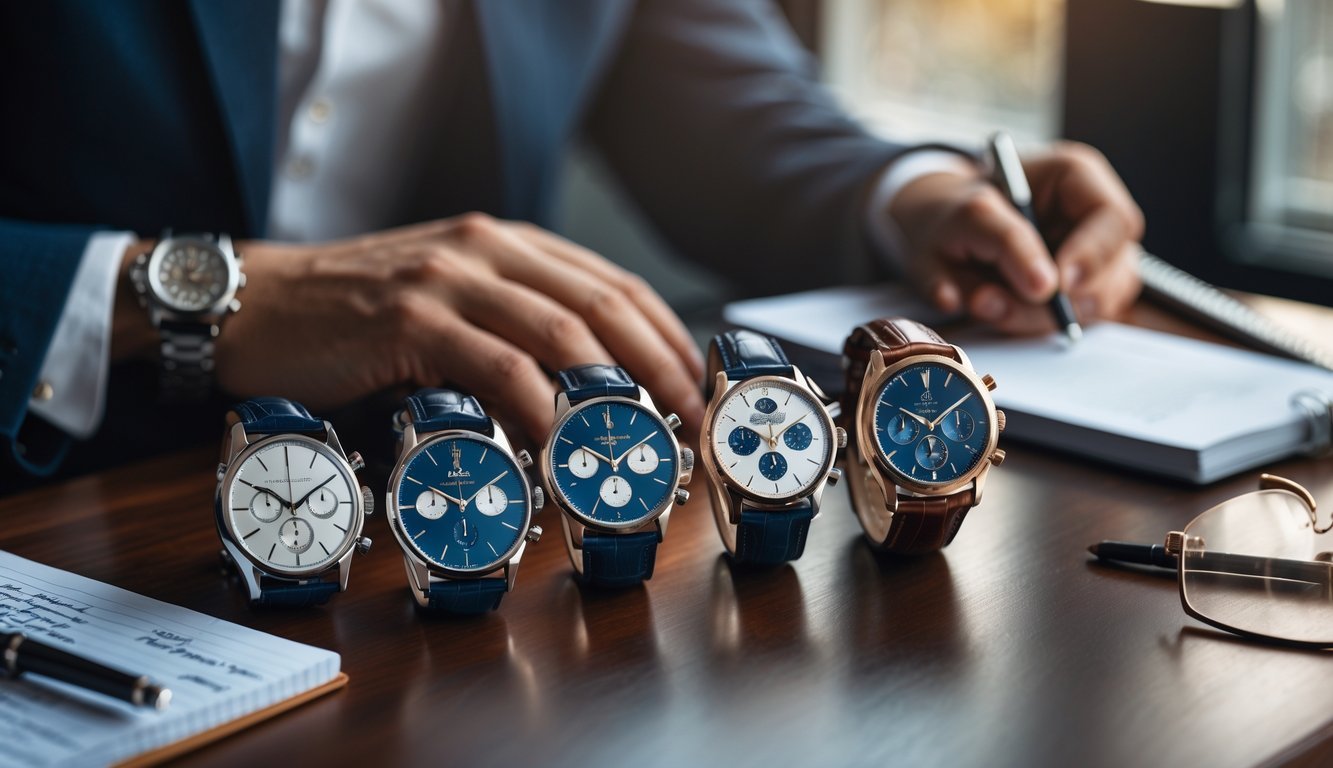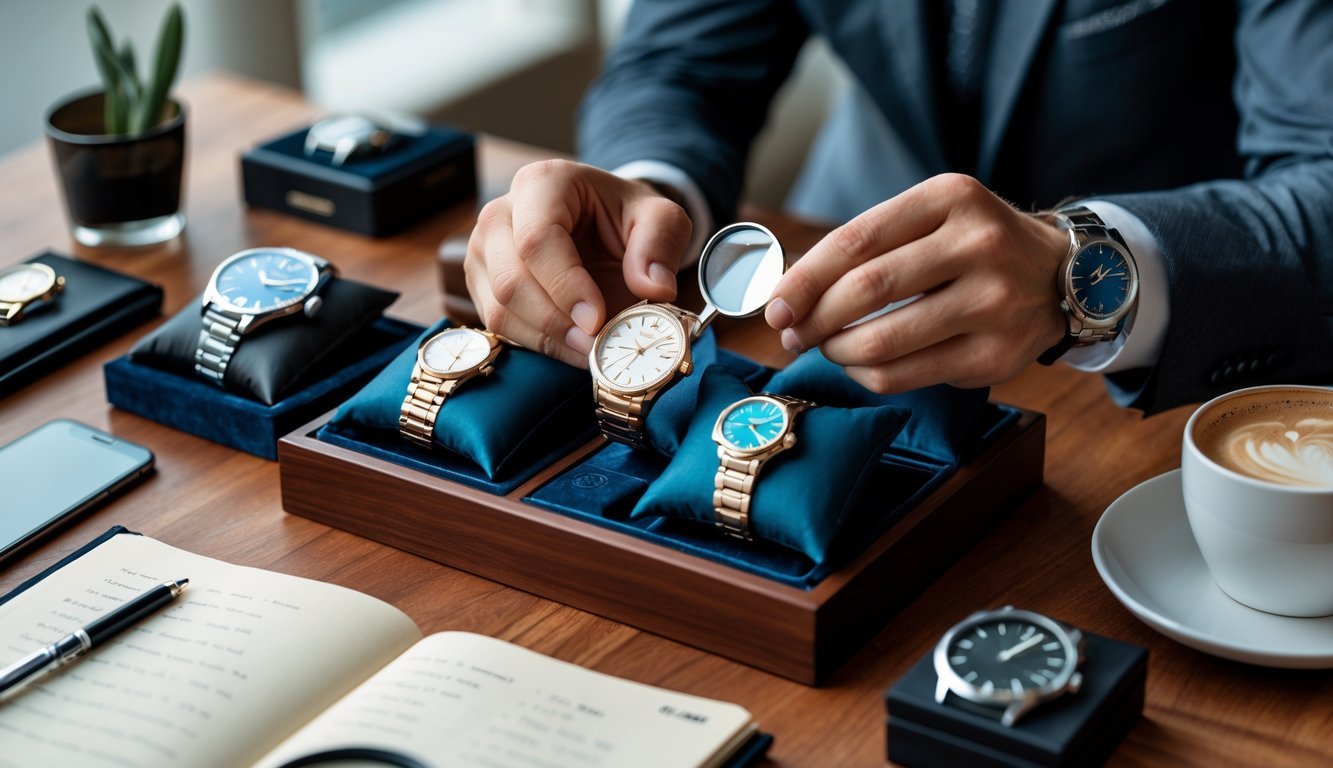Buying your first luxury watch can feel pretty overwhelming.
There are hundreds of brands, so many styles, and price tags that run from thousands to, honestly, millions of dollars.
To pick the right luxury watch, you’ve got to know your budget, what style you like, and which features actually fit your lifestyle—way before you fall in love with a brand or model. A lot of beginners make expensive mistakes by chasing big names or letting salespeople rush them, without really knowing what makes a watch worth the price.
The luxury watch market hit $29.1 billion in 2024 and just keeps growing.
People are catching on that these watches aren’t just about looks—they’re also investments.
Smart buyers learn how to spot quality craftsmanship, figure out movement types, and get a sense of which brands actually hold value.
You’ll want to know about case materials, water resistance, and warranty coverage before you swipe your card.
This guide covers everything from setting a budget to what features separate truly exceptional watches from ones that just have a fancy logo.
You’ll get the basics on analog vs. digital, what drives prices, and which brands give beginners the most for their money.
Key Takeaways
- Start with your budget and lifestyle before you get attached to a brand or model
- Knowing about movement types, materials, and build quality helps you spot real value
- Check out brand reputation and resale value if you want your purchase to be smart long-term
Key Features to Look for When Buying Your First Luxury Watch

The movement type decides how your watch keeps time and what kind of maintenance you’ll need.
Good materials like sapphire crystal and precious metals make a watch last longer and keep its value.
Understanding Watch Movements: Quartz vs. Automatic Winding
Quartz movements run on a battery and use a tiny vibrating crystal for super-accurate time.
They’re easy to own, cheap to service, and you just need to swap the battery every couple of years.
Automatic winding movements use mechanical gears powered by your wrist’s motion.
These old-school movements really show off Swiss craftsmanship.
They need more care, but they’ve got a certain prestige.
Here’s a quick comparison:
| Feature | Quartz | Automatic |
|---|---|---|
| Accuracy | ±15 seconds/month | ±20 seconds/day |
| Maintenance | Battery replacement | Regular servicing |
| Price | Lower | Higher |
| Prestige | Moderate | High |
Automatic watches stop if you don’t wear them for a day or two, so you’ll have to wind them or use a watch winder.
Quartz watches just keep ticking, no matter how often you wear them.
Importance of Materials: Cases, Straps, and Sapphire Crystal
Case materials make a huge difference in how your watch looks and lasts.
Stainless steel resists corrosion and scratches better than softer metals.
Gold looks fantastic but you’ll need to be more careful with it.
Titanium is lighter than steel and resists scratches, but it can feel a bit different on the wrist.
Ceramic cases laugh at scratches but can shatter if you drop them on something hard.
Sapphire crystal is almost impossible to scratch—only a diamond can scratch it.
Mineral crystal is cheaper but gets scratched more easily.
Strap options to think about:
- Leather: Classic, but you’ll probably need to replace it every year or two
- Metal bracelet: Tough, adjustable, and matches the case
- Rubber: Great for water and sports, super comfy
- Fabric: Light, casual, and easy to clean
Assessing Watch Functions: Unidirectional Rotating Bezel and More
A unidirectional rotating bezel only moves one way, so you can’t accidentally extend your dive time underwater.
It’s a safety thing for divers, but it’s handy for timing anything, really.
Water resistance matters too:
- 30m: Okay for splashes
- 100m: Fine for swimming and snorkeling
- 300m: Good for diving
- 500m+: That’s for serious divers
Complications are just extra features beyond telling time.
Think date displays, stopwatch functions, and extra hands for tracking other time zones.
The crown should turn smoothly when you wind or set the time.
Screw-down crowns help with water resistance, but you’ll need to unscrew them to adjust anything.
People are looking for watches with more features and better materials these days, and that’s pushing up demand.
Choosing the Right Luxury Watch Style and Brand

Finding the right luxury watch means knowing the differences between high-end brands and picking features that actually fit your life.
The strap you choose really changes the comfort and style, so don’t overlook that if you’re just starting out.
Comparing High-End Watches for Beginners
Entry-level luxury watches from big brands are usually the best way to start.
Omega Seamaster and Cartier Santos give you great craftsmanship without the wild prices of Rolex or Patek Philippe.
Swiss and German luxury watches each have their own vibe.
Swiss names like Omega and Tissot focus on precision and tradition.
German brands like A. Lange & Söhne push technical boundaries and have unique looks.
When you’re comparing brands, keep these in mind:
- Heritage and reputation – Big names usually hold value better
- Movement quality – Automatics need less maintenance than you’d think
- Case materials – Steel is tough, gold is all about status
- Water resistance – Aim for 100m minimum if you’ll wear it daily
Top-tier watches from brands like Rolex keep their value because they don’t make too many and everyone wants one.
The Submariner or GMT-Master II often go up in value.
Budget definitely matters.
Entry-level luxury watches start around $2,000-$5,000.
Middle options sit between $5,000-$15,000.
If you want the very best, you’ll spend $20,000 or more, but you get amazing craftsmanship and potential investment upside.
Selecting the Perfect Strap: Black Leather Strap and Alternatives
Your strap really changes how the watch feels and looks.
A black leather strap is perfect for business and formal events, especially with a suit.
Leather straps give you:
- That classic, timeless look
- Comfort for daily wear
- Easy swaps and lots of customization
- Great for dress and casual watches
Metal bracelets are different.
Stainless steel is tough and water-resistant, making it a good pick for sports or casual watches, but it can feel heavy after a while.
Rubber and fabric straps work well for active people.
They handle sweat and water, and they’re easy to clean.
NATO straps are super tough and have a cool, military style.
Matching strap colors is worth thinking about.
Black leather looks sharp with silver or white gold cases.
Brown leather pairs nicely with rose or yellow gold.
What to look for in a good strap:
- Genuine leather – Go for full-grain or top-grain if you can
- Stitching – Hand-stitched edges usually mean better quality
- Buckle material – Match it to your watch case
- Thickness – Around 3-4mm is comfy and durable
Having a few straps on hand keeps things fresh.
Quick-release pins make it easy to switch between leather, metal, and fabric to fit your plans.
Frequently Asked Questions

New buyers often get stuck picking brands, figuring out quality, and setting a budget.
If you know about maintenance, resale value, and what actually matters, you’ll feel way more confident.
What are the key factors to consider when purchasing a first luxury watch?
Start with your budget.
Pick a price range that won’t stress your wallet.
Think about where you’ll wear the watch.
Dress watches are great for formal events, but sports watches handle everyday use better.
Movement type matters for price and upkeep.
Automatics need servicing every 3-5 years, while quartz watches are easier to maintain.
Case size affects comfort and style.
Measure your wrist—most luxury watches land between 38mm and 44mm.
Brand reputation affects resale.
Well-known brands like Breitling and Longines usually hold value better than smaller names.
How can beginners determine which luxury watch brand suits their style and budget?
Figure out your style first.
Classic designs fit more traditional tastes, while bold styles are for those who want to stand out.
Check out different price ranges.
Entry-level luxury starts at about $1,000, while mid-tier runs from $3,000 to $10,000.
Go to authorized dealers and try on a few.
Seeing how a watch feels on your wrist is a game-changer.
Read reviews and browse watch forums.
Real owners share useful tips about reliability and what it’s like to own a watch long-term.
Think about each brand’s heritage and specialty.
Some brands are famous for dive watches, others for dress or aviation watches.
What are the top luxury watch brands recommended for new collectors?
Swiss brands run the show for a reason.
They bring top quality and strong resale value.
Rolex is the most famous luxury watch brand.
Their Submariner and Datejust are solid choices for starting a collection.
Omega gives you lots of value with their Speedmaster and Seamaster lines.
You get Swiss quality but at a more approachable price.
Tudor, which is basically Rolex’s sibling, offers similar quality for less.
Their Black Bay and Pelagos models are favorites for new collectors.
Grand Seiko from Japan is also fantastic.
They compete with Swiss brands in quality and price.
TAG Heuer and Breitling are great for sporty styles.
Both have excellent chronographs and dive watches for active folks.
How do you assess the quality and craftsmanship of a luxury watch?
Check the case finishing.
Top watches feel smooth, with no rough edges or tool marks.
Look at the dial.
Everything should line up, and the text should be crisp and clean.
Test the crown and pushers.
They should turn and press smoothly, no grinding or sticking.
Check the bracelet or strap. Luxury watches use top materials like solid metal or real leather.
If the watch has a display back, peek at the movement.
The best movements look beautifully finished and the rotor spins smoothly.
Double-check the water resistance matches your needs.
Luxury watches should live up to their specs.
What are the maintenance and care guidelines for a luxury timepiece?
Keep your watch in a watch box or soft pouch when you’re not wearing it.
That helps avoid scratches and damage.
Wipe the case and bracelet with a soft cloth often.
For deeper cleaning, use a little mild soap and water, but don’t dunk the watch if you don’t have to.
Wind your automatic watches if you aren’t wearing them every day.
A watch winder can help if you have more than one.
Get your watch serviced by a pro every 3-5 years.
That keeps it ticking accurately and saves you from big repair bills.
Avoid extreme temperatures and magnets.
Both can mess with timekeeping.
Swap out worn straps before they break.
Good replacement straps keep your watch looking sharp and protect the lugs.
How does one navigate the resale market when investing in a luxury watch?
Start by checking out current market prices before you buy or sell.
Sites like Chrono24 or WatchStation usually have up-to-date info.
If you can, buy from authorized dealers.
You’ll know the watch is real, and you’ll get the right paperwork for any future resale.
Hang onto the original box and all the documents.
Buyers pay more for full sets with everything included.
Look at models that everyone seems to want.
Sports watches and limited editions usually keep their value better than dressier options.
Keep in mind, luxury watches aren’t always a sure bet as investments.
The market shifts, and what’s popular today might not be tomorrow.
If you’re ready to sell, stick with dealers who have a good reputation.
They tend to offer fair prices and make sure your watch is authentic.


